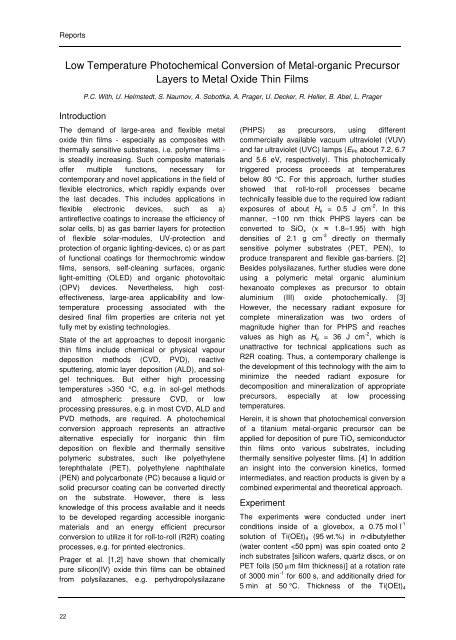Biennial Report 2016/2017
Create successful ePaper yourself
Turn your PDF publications into a flip-book with our unique Google optimized e-Paper software.
<strong>Report</strong>s<br />
Low Temperature Photochemical Conversion of Metal-organic Precursor<br />
Layers to Metal Oxide Thin Films<br />
P.C. With, U. Helmstedt, S. Naumov, A. Sobottka, A. Prager, U. Decker, R. Heller, B. Abel, L. Prager<br />
Introduction<br />
The demand of large-area and flexible metal<br />
oxide thin films - especially as composites with<br />
thermally sensitive substrates, i.e. polymer films -<br />
is steadily increasing. Such composite materials<br />
offer multiple functions, necessary for<br />
contemporary and novel applications in the field of<br />
flexible electronics, which rapidly expands over<br />
the last decades. This includes applications in<br />
flexible electronic devices, such as a)<br />
antireflective coatings to increase the efficiency of<br />
solar cells, b) as gas barrier layers for protection<br />
of flexible solar-modules, UV-protection and<br />
protection of organic lighting-devices, c) or as part<br />
of functional coatings for thermochromic window<br />
films, sensors, self-cleaning surfaces, organic<br />
light-emitting (OLED) and organic photovoltaic<br />
(OPV) devices. Nevertheless, high costeffectiveness,<br />
large-area applicability and lowtemperature<br />
processing associated with the<br />
desired final film properties are criteria not yet<br />
fully met by existing technologies.<br />
State of the art approaches to deposit inorganic<br />
thin films include chemical or physical vapour<br />
deposition methods (CVD, PVD), reactive<br />
sputtering, atomic layer deposition (ALD), and solgel<br />
techniques. But either high processing<br />
temperatures >350 °C, e.g. in sol-gel methods<br />
and atmospheric pressure CVD, or low<br />
processing pressures, e.g. in most CVD, ALD and<br />
PVD methods, are required. A photochemical<br />
conversion approach represents an attractive<br />
alternative especially for inorganic thin film<br />
deposition on flexible and thermally sensitive<br />
polymeric substrates, such like polyethylene<br />
terephthalate (PET), polyethylene naphthalate<br />
(PEN) and polycarbonate (PC) because a liquid or<br />
solid precursor coating can be converted directly<br />
on the substrate. However, there is less<br />
knowledge of this process available and it needs<br />
to be developed regarding accessible inorganic<br />
materials and an energy efficient precursor<br />
conversion to utilize it for roll-to-roll (R2R) coating<br />
processes, e.g. for printed electronics.<br />
Prager et al. [1,2] have shown that chemically<br />
pure silicon(IV) oxide thin films can be obtained<br />
from polysilazanes, e.g. perhydropolysilazane<br />
(PHPS) as precursors, using different<br />
commercially available vacuum ultraviolet (VUV)<br />
and far ultraviolet (UVC) lamps (E Ph about 7.2, 6.7<br />
and 5.6 eV, respectively). This photochemically<br />
triggered process proceeds at temperatures<br />
below 80 °C. For this approach, further studies<br />
showed that roll-to-roll processes became<br />
technically feasible due to the required low radiant<br />
exposures of about H e = 0.5 J cm -2 . In this<br />
manner, ~100 nm thick PHPS layers can be<br />
converted to SiO x (x ≈ 1.8–1.95) with high<br />
densities of 2.1 g cm -3 directly on thermally<br />
sensitive polymer substrates (PET, PEN), to<br />
produce transparent and flexible gas-barriers. [2]<br />
Besides polysilazanes, further studies were done<br />
using a polymeric metal organic aluminium<br />
hexanoato complexes as precursor to obtain<br />
aluminium (III) oxide photochemically. [3]<br />
However, the necessary radiant exposure for<br />
complete mineralization was two orders of<br />
magnitude higher than for PHPS and reaches<br />
values as high as H e = 36 J cm -2 , which is<br />
unattractive for technical applications such as<br />
R2R coating. Thus, a contemporary challenge is<br />
the development of this technology with the aim to<br />
minimize the needed radiant exposure for<br />
decomposition and mineralization of appropriate<br />
precursors, especially at low processing<br />
temperatures.<br />
Herein, it is shown that photochemical conversion<br />
of a titanium metal-organic precursor can be<br />
applied for deposition of pure TiO x semiconductor<br />
thin films onto various substrates, including<br />
thermally sensitive polyester films. [4] In addition<br />
an insight into the conversion kinetics, formed<br />
intermediates, and reaction products is given by a<br />
combined experimental and theoretical approach.<br />
Experiment<br />
The experiments were conducted under inert<br />
conditions inside of a glovebox, a 0.75 mol l -1<br />
solution of Ti(OEt) 4 (95 wt.%) in n-dibutylether<br />
(water content


